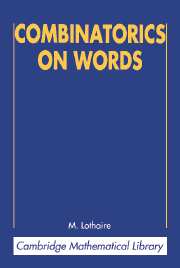Book contents
- Frontmatter
- Contents
- Foreword
- Preface
- Preface to this edition
- Chapter 1 Words
- Chapter 2 Square-Free Words and Idempotent Semigroups
- Chapter 3 Van der Waerden's Theorem
- Chapter 4 Repetitive Mappings and Morphisms
- Chapter 5 Factorizations of Free Monoids
- Chapter 6 Subwords
- Chapter 7 Unavoidable Regularities in Words and Algebras with Polynomial Identities
- Chapter 8 The Critical Factorization Theorem
- Chapter 9 Equations in Words
- Chapter 10 Rearrangements of Words
- Chapter 11 Words and Trees
- Bibliography
- Index
Chapter 9 - Equations in Words
Published online by Cambridge University Press: 04 November 2009
- Frontmatter
- Contents
- Foreword
- Preface
- Preface to this edition
- Chapter 1 Words
- Chapter 2 Square-Free Words and Idempotent Semigroups
- Chapter 3 Van der Waerden's Theorem
- Chapter 4 Repetitive Mappings and Morphisms
- Chapter 5 Factorizations of Free Monoids
- Chapter 6 Subwords
- Chapter 7 Unavoidable Regularities in Words and Algebras with Polynomial Identities
- Chapter 8 The Critical Factorization Theorem
- Chapter 9 Equations in Words
- Chapter 10 Rearrangements of Words
- Chapter 11 Words and Trees
- Bibliography
- Index
Summary
Introduction
Let us consider two words x, y of the free monoid A*, satisfying the equality:
By Proposition 1.3.2 of Chapter 1, there exist a word u ∈ A* and two integers n, p ≥ 0 such that
In this chapter, we will view x and y as the letters of an alphabet Ξ. We will say that xy = yx is an equation in the unknowns Ξ = {x, y} and that the morphism α: Ξ* → A* defined by α(x) = un and α(y) = up is a solution of the equation. Observe that all solutions of this particular equation are of this type.
The basic notions on equations are presented in Section 9.1. In Section 9.2, we consider a few equations whose families of solutions admit a finite description, as in the preceding example. Indeed, the family of solutions of Eq. (9.0.1) is entirely described by the unique expression (9.0.2), where u runs over all words and n, p over all positive integers. This idea is formalized in Section 9.3, which introduces the notion of parametrizable equations and where it is recalled that all equations in three unknowns are parametrizable.
Not all equations are parametrizable, however. We are thus led in Section 9.4 to define the rank of an equation, which is the maximum number of the letters occurring in the expression of particular solutions called principal.
- Type
- Chapter
- Information
- Combinatorics on Words , pp. 162 - 183Publisher: Cambridge University PressPrint publication year: 1997

